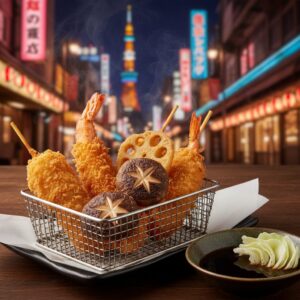Step off the train at Tsuruhashi Station, and the world changes in an instant. The polished, predictable rhythm of urban Japan dissolves into a vibrant, chaotic, and utterly intoxicating symphony of life. You’re not just in a different neighborhood; you’ve tumbled into the heart of another culture, a place where the air itself is thick with the tantalizing smoke of grilled meat and the sharp, fermented perfume of kimchi. This is Tsuruhashi Market, Osaka’s sprawling, electric Koreatown, a labyrinth of covered arcades and narrow alleyways that pulses with a raw energy unlike anywhere else in the city. It’s a sensory overload in the most glorious way possible, a place where the lines between Japan and Korea blur into a beautiful, delicious mosaic. Forget your neat itinerary for a moment; Tsuruhashi isn’t a place you simply see, it’s a place you feel, taste, and breathe. It’s a living, breathing testament to history, community, and the universal language of incredible food, a destination that promises not just a meal, but an unforgettable adventure for the soul.
The Electric Buzz of Tsuruhashi: A Symphony for the Senses
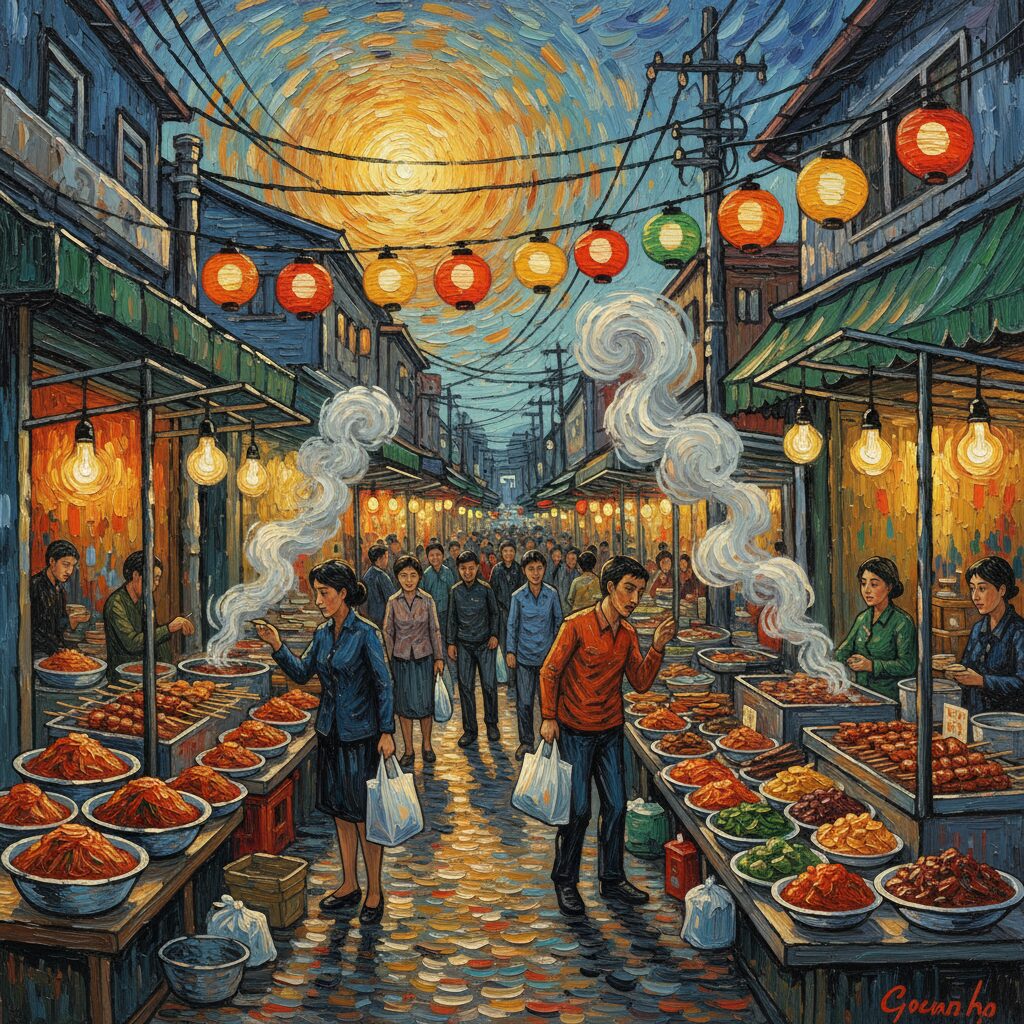
The moment you step through the ticket gates at Tsuruhashi, you are immediately caught up in its vibrant current. The atmosphere shifts, thickening with the unmistakable scent of yakiniku—a savory, smoky hint of what lies ahead. This isn’t a mere suggestion of food; it’s an enveloping aroma that clings to your clothes and reshapes your plans for the day. Your initial steps carry you into the shotengai, the covered shopping arcade, a labyrinth where sunlight struggles to filter through the canopy of storefronts and awnings. The soundscape is a rich blend of chatter in both Japanese and Korean, the sizzle of hotplates, the rhythmic chopping of knives on wooden blocks, and the cheerful, persistent calls of vendors. “Irasshaimase!” blends with “Eoseo oseyo!”—a warm greeting spoken in two languages.
It’s a world apart from the tranquil temples and minimalist boutiques you might find elsewhere. Tsuruhashi is gloriously, unapologetically cluttered. Shops spill out into narrow walkways. Bright red buckets of kimchi, glistening with chili paste, are stacked high, forming walls of vivid color. Dried fish hang like silver curtains, their salty aroma mingling with the sweetness of roasting chestnuts. Elderly women with kind, weathered faces oversee stalls heaped with homemade namul, an assortment of seasoned vegetable side dishes, each a miniature work of art. The ground beneath your feet is often damp, a testament to the continuous buzz of commerce and the washing of fresh produce. There’s a beautiful chaos to it all—a sense of organized disarray that feels genuine and alive. You must weave through crowds of shoppers, delivery carts, and locals catching up with friends. It compels you to slow down, to engage with your environment, to become part of the flow rather than a mere observer. This is the pulse of Tsuruhashi—a relentless, thrilling rhythm that draws you ever deeper into its embrace.
A Taste of History: The Roots of Osaka’s Koreatown
To truly appreciate the vibrant energy of Tsuruhashi, one must understand its story, which is intricately tied to the modern history of Japan and Korea. The area’s identity as a Koreatown began to emerge in the years following World War II. Many Koreans had arrived in Japan during the colonial period, and after the war, this district—once a black market—became a crucial hub for the Zainichi Korean community, ethnic Koreans living in Japan. It served as a place of refuge, commerce, and cultural preservation. The market developed naturally from the needs of this community, offering familiar foods, goods, and a sense of home in a foreign land.
As you walk through the market today, you can sense the layers of this history. Many of the businesses have been handed down through generations. The grandmother carefully arranging her kimchi stall may be using a recipe her own mother brought from Korea. The butcher skillfully slicing marbled beef continues a family tradition that began in a small stall decades ago. This is not a themed attraction; it is a community with deep roots. The market’s very existence tells a story of resilience, of creating a space where Korean culture could not only survive but thrive. This historical background adds profound depth to the experience. Every delicious bite of chijimi, every colorful jeogori dress displayed in a shop window, is part of a larger narrative of identity and belonging. Understanding this turns a simple market visit into a meaningful cultural immersion, allowing you to appreciate the spirit and perseverance that have shaped Tsuruhashi into the landmark it is today.
Culinary Conquest: Your Ultimate Tsuruhashi Food Journey
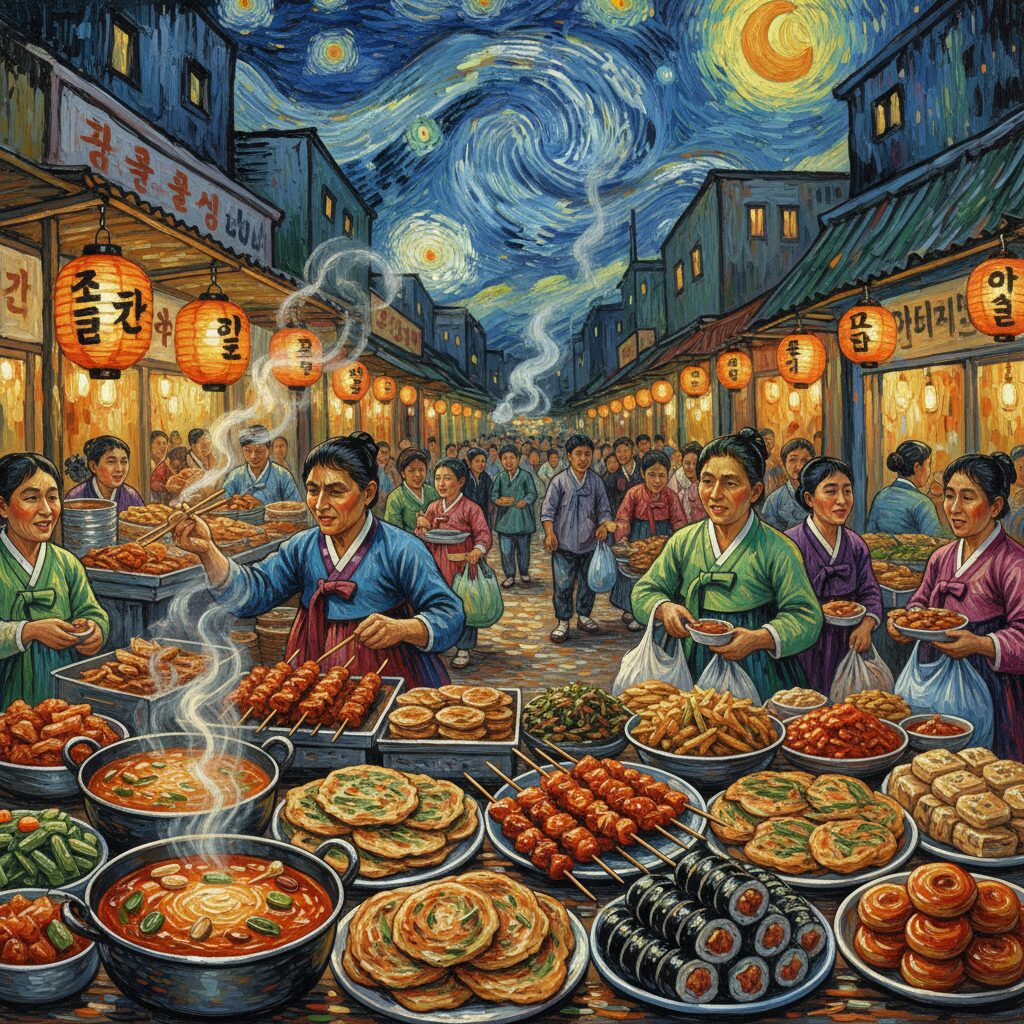
Prepare your senses, as Tsuruhashi is, above all, a pilgrimage destination for food enthusiasts. The vast variety can be overwhelming, but diving right in is the only way to truly experience its magic. The culinary scene here is a vibrant blend of traditional flavors and contemporary trends, catering to every palate and budget.
Yakiniku Paradise
The undisputed highlight of Tsuruhashi’s food scene is yakiniku, or grilled meat. This neighborhood reportedly boasts the highest concentration of yakiniku restaurants per square meter in Japan. The experience is both interactive and intoxicating. You sit at a table with a grill embedded in the center, served plates of raw, beautifully marbled meat. You become the chef, grilling each piece to your liking. The sizzle as the meat meets the hot grill, the fragrant puff of smoke, and the communal joy of sharing a meal make it a fully immersive sensory experience.
You’ll find everything from upscale establishments offering premium cuts of Kobe beef to tiny, standing-room-only stalls where you can grab a few skewers of horumon (offal) for a quick, bold snack. Don’t hesitate to try different cuts. Kalbi (short ribs) is a classic—tender and flavorful. Harami (skirt steak) is another favorite, known for its rich taste. For the adventurous, horumon is a local specialty, cherished for its unique textures and flavors when grilled crispy. The dipping sauces, or tare, are essential—usually a secret blend of soy sauce, sugar, garlic, and sesame oil that perfectly complements the smoky, charred meat. This is more than just a meal; it’s a ritual, a celebration of flavors that defines Tsuruhashi’s culinary heart.
Kimchi Kingdom
You can’t walk ten feet in Tsuruhashi Market without encountering kimchi. The variety is astounding. Forget the standard cabbage kimchi from supermarkets; here, kimchi reveals itself in a colorful array of textures and spice levels. There are long, whole cucumbers (oi sobagi) stuffed with fiery paste, crisp white daikon radish cubes (kkakdugi), and seasonal varieties made with everything from green onions to perilla leaves. The vendors, known as “Kimchi Obasan” (Kimchi Aunties), are true masters of their craft. They eagerly offer samples, inviting you to taste the difference between freshly made batches and those fermented longer for a deeper, more sour flavor. The sight of these mounds of red is striking—a sea of crimson and garnet that captures the soul of Korean cuisine. Buying kimchi here is an interactive experience; you can chat with the vendors, learn their unique family recipes, and leave with a bag of freshly packed, authentic flavor guaranteed to elevate any meal.
Street Food Staples
Beyond the sit-down eateries, the real joy of Tsuruhashi lies in its street food. Wandering the alleys, grazing your way, is the perfect way to sample a wide range of flavors. A must-try is chijimi, a savory Korean pancake. You’ll see them sizzling on large griddles, filled with ingredients like green onions, seafood, or kimchi. Served hot and crispy with a tangy dipping sauce, it’s ultimate comfort food. Another common favorite is tteokbokki, chewy cylindrical rice cakes bathed in a bright red, gochujang-based sauce that’s both sweet and spicy. It’s addictive and beloved by locals. For a variation, look for Korean-style fried chicken, double-fried to achieve an incredibly crispy skin, often coated in a sticky, sweet-and-spicy glaze. For a sweet ending, seek out a stall selling hotteok. These delicious pancakes are filled with a mix of brown sugar, cinnamon, and nuts. When pan-fried, the filling melts into a molten syrup, creating a warm, gooey treat perfect for a chilly day. Every stall offers a little taste of culinary heaven, a quick and delicious way to fuel your explorations.
Navigating the Labyrinth: Exploring the Different Zones of the Market
Tsuruhashi is not a single, unified market but rather a collection of smaller markets and shopping streets, each with its own unique character. Familiarizing yourself with the layout can enhance your visit. Surrounding the station are the main covered arcades, known as the Tsuruhashi Shotengai, which represent the oldest and most traditional section of the market. The alleys are very narrow and crowded with tiny stalls offering everything from fresh fish and vegetables to kimchi, meat, and traditional Korean pantry essentials. This area is the vibrant, pulsating heart of Tsuruhashi, a place that seems frozen in time.
A short walk from the station leads you to the Miyukidori Shopping Street, better known as Korea Town. This district has a more modern and polished atmosphere. The street is wider, and the shops are larger, emphasizing contemporary Korean culture. Here, you’ll find the newest K-beauty and cosmetics stores, trendy cafés serving elaborate desserts like bingsu (shaved ice), and shops playing K-pop music while selling merchandise from popular idol groups. It’s a lively, youthful area that stands in stark contrast to the old-world charm of the market arcades. Together, these two areas offer a complete representation of Korean culture in Osaka, spanning from its historical foundations to its modern, global influence. Visiting both is crucial to fully appreciating the neighborhood’s diversity.
More Than Just a Market: Shopping and Cultural Finds
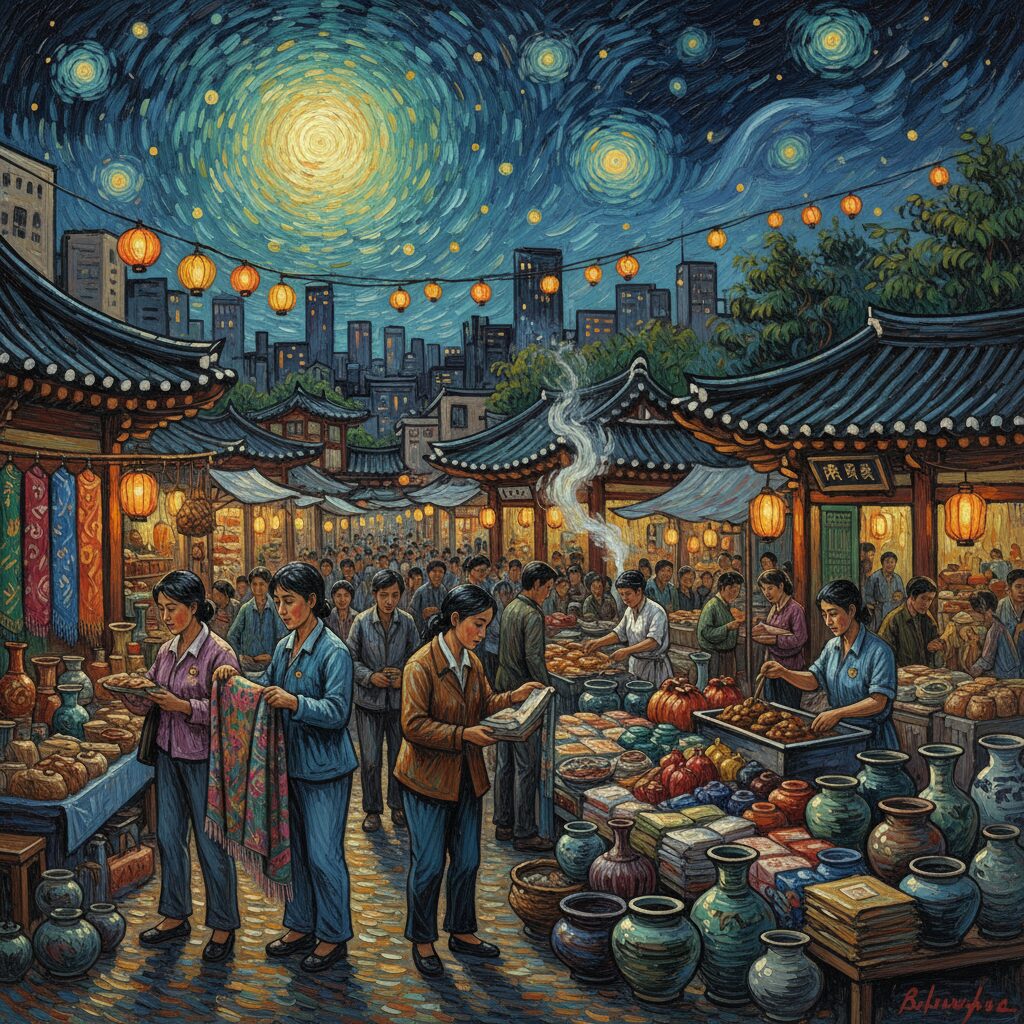
While food is undoubtedly the primary attraction, Tsuruhashi provides a rich shopping experience that extends well beyond the culinary. For fashion and beauty enthusiasts, Korea Town is a treasure chest. You can discover a wide array of Korean cosmetic brands, ranging from popular labels to smaller, niche ones. The stores are often staffed by knowledgeable employees who can guide you through the renowned 10-step Korean skincare routine or help you find the ideal shade of lip tint. The clothing shops feature a blend of trendy, fast-fashion items inspired by Seoul street style.
Those interested in more traditional goods will find the older market arcades worth exploring. Here, shops offer beautiful fabrics for making hanbok, the traditional Korean dress. The intricate embroidery and vibrant colors are truly stunning. You can also find Korean kitchenware, such as stone bowls (dolsot) used for bibimbap or the small, elegant ceramic dishes for serving side dishes (banchan). These items make unique and practical souvenirs. This mix of modern and traditional elements is what makes shopping in Tsuruhashi so captivating. Within a few minutes’ walk, you can pick up a trendy face mask in one store and a piece of handcrafted pottery in the next.
Practical Tips for Your Tsuruhashi Adventure
A bit of planning can greatly enhance your visit to this bustling market, making it smooth and enjoyable. Getting here is very easy. Tsuruhashi Station is a major hub served by the JR Osaka Loop Line, the Kintetsu Line, and the Osaka Metro Sennichimae Line, offering direct access from key areas such as Namba, Umeda, and Tennoji. Once you arrive, the market is literally just outside the station.
The best time to visit is from late morning through the afternoon when the market is at its most vibrant, with all stalls open and the atmosphere buzzing with activity. Keep in mind that many smaller, family-run shops in the traditional arcade close fairly early, often around 5:00 or 6:00 PM. Additionally, Wednesday is a common closing day for many businesses in the area, so if possible, plan your visit for another day of the week.
Regarding logistics, there are a few important things to note. While more vendors are accepting cards, many smaller food stalls and market sellers still operate on a cash-only basis, so it’s wise to carry plenty of yen. Wear comfortable shoes, as you’ll be walking a lot on uneven pavement in crowded alleys. Most importantly, come hungry and ready to explore. The best way to experience Tsuruhashi is with a sense of adventure—try things you’ve never heard of and let your nose guide you to your next delicious discovery. Vendors are generally friendly and happy to explain their products, so don’t hesitate to point and ask. A little curiosity will be rewarded with amazing flavors and warm interactions.
A Final Sip of Korean Tea: Reflections on Tsuruhashi
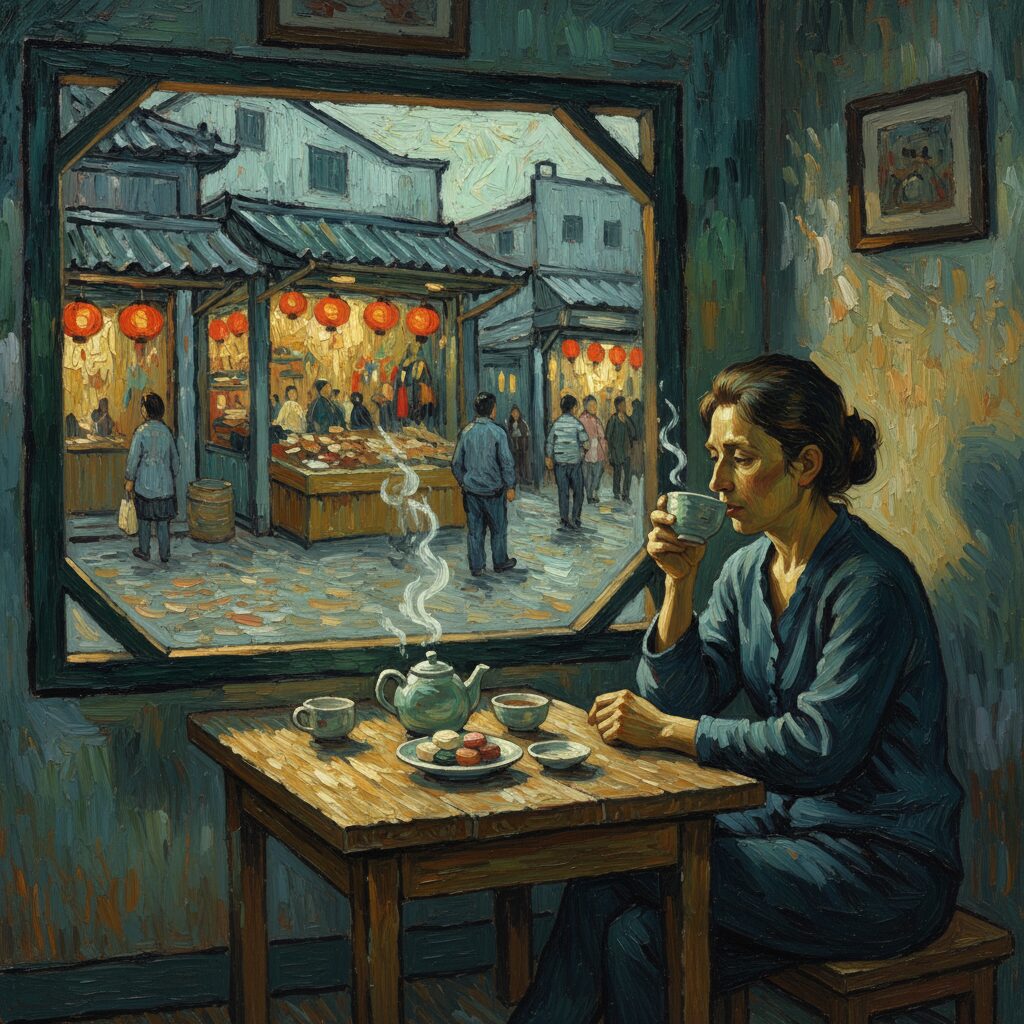
Leaving Tsuruhashi feels like emerging from a vivid dream. As you step back onto the train platform, the smoky aroma of yakiniku gradually fades, replaced by the neutral city air. Yet the experience remains. Tsuruhashi is more than just a destination; it’s a vivid reminder of the rich cultural tapestry that makes Osaka so captivating. It’s a place where history lives not in museums but in the recipes, faces, and stories of its people. It stands as a testament to the idea that a place can be both Japanese and Korean, honoring both traditions to create something truly unique. A visit here is a whirlwind of sensations—a journey that defies expectations and rewards you with some of the most genuine, flavorful, and soulful food you’ll ever savor. So when you visit Osaka, let yourself get lost in the maze of Tsuruhashi. Wander without a plan, follow the scent of something delicious, and find your own special corner of this incredible, vibrant world. It’s an adventure that will linger long after the last bite is gone.




